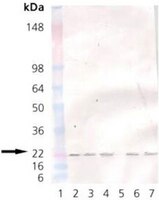421400 Sigma-AldrichAnti-KDEL Receptor Mouse mAb (KR-10)
Recommended Products
Overview
| Replacement Information |
|---|
Key Spec Table
| Species Reactivity | Host | Antibody Type |
|---|---|---|
| B, Ca, Ch, Dr, Ht, H, Mk, M, Porcine, Rb, R, Sh, Xn | M | Monoclonal Antibody |
| Product Information | |
|---|---|
| Form | Liquid |
| Formulation | Undiluted ascites. |
| Negative control | CHO-K1 cells |
| Positive control | Heat shocked HeLa cells, PC-12 cells, Heat shocked 3T3 cells |
| Preservative | None |
| Quality Level | MQ100 |
| Physicochemical Information |
|---|
| Dimensions |
|---|
| Materials Information |
|---|
| Toxicological Information |
|---|
| Safety Information according to GHS |
|---|
| Safety Information |
|---|
| Product Usage Statements |
|---|
| Packaging Information |
|---|
| Transport Information |
|---|
| Supplemental Information |
|---|
| Specifications |
|---|
| Global Trade Item Number | |
|---|---|
| Catalogue Number | GTIN |
| 421400 | 0 |
Documentation
Anti-KDEL Receptor Mouse mAb (KR-10) Certificates of Analysis
| Title | Lot Number |
|---|---|
| 421400 |
References
| Reference overview |
|---|
| Aoe, T., et al. 1997. EMBO J. 16, 7305. Tang, B.L., et al. 1994. Eur. J. Cell Biol. 65, 298. Tang, B.L., et al. 1993. J. Cell Biol. 120, 325. Lewis, M.J., and Pelham, H.R. 1990. Nature 348, 162. |








